I want to install SQL Server Express (preferably 2008 or 2014) silently using Advanced Installer. I followed the instructions in two document created by advanced installer online:
How to Install SQL Server Express and here is a sample *.aip file to show what the settings need to install SQL server Express silently.
My scenarios:
Get error during simple installing:
However, I get this error:
I already test manually SQL Server Express setup.exe on the target system. So the file and target system doesn't have any problems.
I'm trying to setup.exe using ConfigurationFile.ini as following in command line:

This is my ConfigurationFile.ini code:
;SQLSERVER2008 Configuration File
[OPTIONS]
; Specify the Instance ID for the SQL Server features you have specified. SQL Server directory structure, registry structure, and service names will reflect the instance ID of the SQL Server instance.
INSTANCEID="BNSDEV"
; Specifies a Setup work flow, like INSTALL, UNINSTALL, or UPGRADE. This is a required parameter.
ACTION="Install"
; Specifies features to install, uninstall, or upgrade. The list of top-level features include SQL, AS, RS, IS, and Tools. The SQL feature will install the database engine, replication, and full-text. The Tools feature will install Management Tools, Books online, Business Intelligence Development Studio, and other shared components.
FEATURES=SQLENGINE,REPLICATION
; Displays the command line parameters usage
HELP="False"
; Specifies that the detailed Setup log should be piped to the console.
INDICATEPROGRESS="False"
; Setup will not display any user interface.
QUIET="False"
; Setup will display progress only without any user interaction.
QUIETSIMPLE="False"
; Specifies that Setup should install into WOW64. This command line argument is not supported on an IA64 or a 32-bit system.
X86="False"
; Detailed help for command line argument ROLE has not been defined yet.
ROLE="AllFeatures_WithDefaults"
; Detailed help for command line argument ENU has not been defined yet.
ENU="True"
; Parameter that controls the user interface behavior. Valid values are Normal for the full UI, and AutoAdvance for a simplied UI.
UIMODE="Normal"
; Specify if errors can be reported to Microsoft to improve future SQL Server releases. Specify 1 or True to enable and 0 or False to disable this feature.
ERRORREPORTING="True"
; Specify the root installation directory for native shared components.
INSTALLSHAREDDIR="C:\Program Files\Microsoft SQL Server"
; Specify the installation directory.
INSTANCEDIR="C:\Program Files\Microsoft SQL Server"
; Specify that SQL Server feature usage data can be collected and sent to Microsoft. Specify 1 or True to enable and 0 or False to disable this feature.
SQMREPORTING="False"
; Specify a default or named instance. MSSQLSERVER is the default instance for non-Express editions and SQLExpress for Express editions. This parameter is required when installing the SQL Server Database Engine (SQL), Analysis Services (AS), or Reporting Services (RS).
INSTANCENAME="BNSDEV"
; Agent account name
AGTSVCACCOUNT="NT AUTHORITY\NETWORK SERVICE"
; Auto-start service after installation.
AGTSVCSTARTUPTYPE="Disabled"
; Startup type for Integration Services.
ISSVCSTARTUPTYPE="Automatic"
; Account for Integration Services: Domain\User or system account.
ISSVCACCOUNT="NT AUTHORITY\NetworkService"
; Controls the service startup type setting after the service has been created.
ASSVCSTARTUPTYPE="Automatic"
; The collation to be used by Analysis Services.
ASCOLLATION="Latin1_General_CI_AS"
; The location for the Analysis Services data files.
ASDATADIR="Data"
; The location for the Analysis Services log files.
ASLOGDIR="Log"
; The location for the Analysis Services backup files.
ASBACKUPDIR="Backup"
; The location for the Analysis Services temporary files.
ASTEMPDIR="Temp"
; The location for the Analysis Services configuration files.
ASCONFIGDIR="Config"
; Specifies whether or not the MSOLAP provider is allowed to run in process.
ASPROVIDERMSOLAP="1"
; A port number used to connect to the SharePoint Central Administration web application.
FARMADMINPORT="0"
; Startup type for the SQL Server service.
SQLSVCSTARTUPTYPE="Automatic"
; Level to enable FILESTREAM feature at (0, 1, 2 or 3).
FILESTREAMLEVEL="0"
; Set to "1" to enable RANU for SQL Server Express.
ENABLERANU="True"
; Specifies a Windows collation or an SQL collation to use for the Database Engine.
SQLCOLLATION="SQL_Latin1_General_CP1_CI_AS"
; Account for SQL Server service: Domain\User or system account.
SQLSVCACCOUNT="NT AUTHORITY\SYSTEM"
; Windows account(s) to provision as SQL Server system administrators.
SQLSYSADMINACCOUNTS="BUILTIN\ADMINISTRATORS"
; Provision current user as a Database Engine system administrator for SQL Server 2008 R2 Express.
ADDCURRENTUSERASSQLADMIN="True"
; Specify 0 to disable or 1 to enable the TCP/IP protocol.
TCPENABLED="1"
; Specify 0 to disable or 1 to enable the Named Pipes protocol.
NPENABLED="0"
; Startup type for Browser Service.
BROWSERSVCSTARTUPTYPE="Disabled"
; Specifies which account the report server NT service should execute under. When omitted or when the value is empty string, the default built-in account for the current operating system.
; The username part of RSSVCACCOUNT is a maximum of 20 characters long and
; The domain part of RSSVCACCOUNT is a maximum of 254 characters long.
RSSVCACCOUNT="NT AUTHORITY\NETWORK SERVICE"
; Specifies how the startup mode of the report server NT service. When
; Manual - Service startup is manual mode (default).
; Automatic - Service startup is automatic mode.
; Disabled - Service is disabled
RSSVCSTARTUPTYPE="Automatic"
; Specifies which mode report server is installed in.
; Default value: “FilesOnly”
RSINSTALLMODE="FilesOnlyMode"
I think there must be a problem with PCUSOURCE. because as fig1 I getting an error as The system can not find the file specified and system looking the sqlSupport.msi.
can anyone help me to solve this problem?
Edited
Here is the last summery.txt for installation:
Overall summary:
Final result: User cancelled
Exit code (Decimal): -2068380094
Exit facility code: 1207
Exit error code: 1602
Exit message: User has cancelled.
Start time: 2017-10-30 13:27:09
End time: 2017-10-30 13:43:48
Requested action: Install
Machine Properties:
Machine name: WINDOWS7-PC
Machine processor count: 2
OS version: Windows 7
OS service pack: Service Pack 1
OS region: United States
OS language: English (United States)
OS architecture: x86
Process architecture: 32 Bit
OS clustered: No
Product features discovered:
Product Instance Instance ID Feature Language Edition Version Clustered
Package properties:
Description: SQL Server Database Services 2008 R2
ProductName: SQL Server 2008 R2
Type: RTM
Version: 10
Installation location: c:\3366571280411213122d3a8c\x86\setup\
Installation edition: EXPRESS
Slipstream: True
SP Level 2
User Input Settings:
ACTION: Install
ADDCURRENTUSERASSQLADMIN: True
AGTSVCACCOUNT: NT AUTHORITY\NETWORK SERVICE
AGTSVCPASSWORD: *****
AGTSVCSTARTUPTYPE: Disabled
ASBACKUPDIR: Backup
ASCOLLATION: Latin1_General_CI_AS
ASCONFIGDIR: Config
ASDATADIR: Data
ASDOMAINGROUP: <empty>
ASLOGDIR: Log
ASPROVIDERMSOLAP: 1
ASSVCACCOUNT: <empty>
ASSVCPASSWORD: *****
ASSVCSTARTUPTYPE: Automatic
ASSYSADMINACCOUNTS: <empty>
ASTEMPDIR: Temp
BROWSERSVCSTARTUPTYPE: Disabled
CONFIGURATIONFILE: C:\Program Files\Microsoft SQL Server\100\Setup Bootstrap\Log\20171030_132528\ConfigurationFile.ini
CUSOURCE:
ENABLERANU: True
ENU: True
ERRORREPORTING: False
FARMACCOUNT: <empty>
FARMADMINPORT: 0
FARMPASSWORD: *****
FEATURES: SQLENGINE,REPLICATION
FILESTREAMLEVEL: 0
FILESTREAMSHARENAME: <empty>
FTSVCACCOUNT: <empty>
FTSVCPASSWORD: *****
HELP: False
INDICATEPROGRESS: False
INSTALLSHAREDDIR: C:\Program Files\Microsoft SQL Server\
INSTALLSHAREDWOWDIR: C:\Program Files\Microsoft SQL Server\
INSTALLSQLDATADIR: <empty>
INSTANCEDIR: C:\Program Files\Microsoft SQL Server\
INSTANCEID: BNSDEV
INSTANCENAME: BNSDEV
ISSVCACCOUNT: NT AUTHORITY\NetworkService
ISSVCPASSWORD: *****
ISSVCSTARTUPTYPE: Automatic
NPENABLED: 0
PASSPHRASE: *****
PCUSOURCE: c:\3366571280411213122d3a8c\PCUSOURCE
PID: *****
QUIET: False
QUIETSIMPLE: False
ROLE: AllFeatures_WithDefaults
RSINSTALLMODE: FilesOnlyMode
RSSVCACCOUNT: NT AUTHORITY\NETWORK SERVICE
RSSVCPASSWORD: *****
RSSVCSTARTUPTYPE: Automatic
SAPWD: *****
SECURITYMODE: <empty>
SQLBACKUPDIR: <empty>
SQLCOLLATION: SQL_Latin1_General_CP1_CI_AS
SQLSVCACCOUNT: NT AUTHORITY\SYSTEM
SQLSVCPASSWORD: *****
SQLSVCSTARTUPTYPE: Automatic
SQLSYSADMINACCOUNTS: windows7-PC\windows7
SQLTEMPDBDIR: <empty>
SQLTEMPDBLOGDIR: <empty>
SQLUSERDBDIR: <empty>
SQLUSERDBLOGDIR: <empty>
SQMREPORTING: False
TCPENABLED: 0
UIMODE: Normal
X86: False
Configuration file: C:\Program Files\Microsoft SQL Server\100\Setup Bootstrap\Log\20171030_132528\ConfigurationFile.ini
Detailed results:
Feature: Database Engine Services
Status: Failed: see logs for details
MSI status: Passed
Configuration status: Passed
Feature: SQL Server Replication
Status: Failed: see logs for details
MSI status: Passed
Configuration status: Passed
Rules with failures:
Global rules:
Scenario specific rules:
Rules report file: C:\Program Files\Microsoft SQL Server\100\Setup Bootstrap\Log\20171030_132528\SystemConfigurationCheck_Report.htm
Exception summary:
The following is an exception stack listing the exceptions in outermost to innermost order
Inner exceptions are being indented
Exception type: Microsoft.SqlServer.Chainer.Infrastructure.CancelException
Message:
User has cancelled.
Stack:
at Microsoft.SqlServer.Configuration.UIExtension.Request.Wait()
at Microsoft.SqlServer.Configuration.UIExtension.UserInterfaceProxy.SubmitAndWait(Request request)
at Microsoft.SqlServer.Configuration.UIExtension.UserInterfaceProxy.NavigateToWaypoint(String moniker)
at Microsoft.SqlServer.Configuration.UIExtension.UserInterfaceService.Waypoint(String moniker)
at Microsoft.SqlServer.Configuration.UIExtension.WaypointAction.ExecuteAction(String actionId)
at Microsoft.SqlServer.Chainer.Infrastructure.Action.Execute(String actionId, TextWriter errorStream)
at Microsoft.SqlServer.Setup.Chainer.Workflow.ActionInvocation.ExecuteActionHelper(TextWriter statusStream, ISequencedAction actionToRun)
Edited After @herman asnswer
as @herman answer, I deleted sqlserverExpr.exe from file and folder then deleted action command from Action too. after that, I add sqlserverExpr.exe from prerequisites, then on setup File Tabs configured values as @herman said. But I get Error like this:
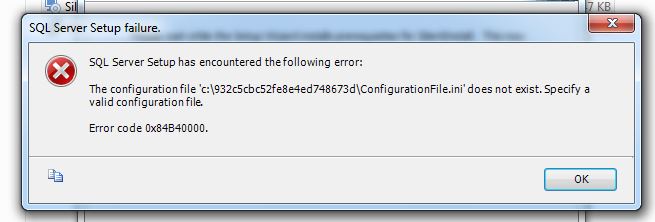
this is my configuration on setup file:
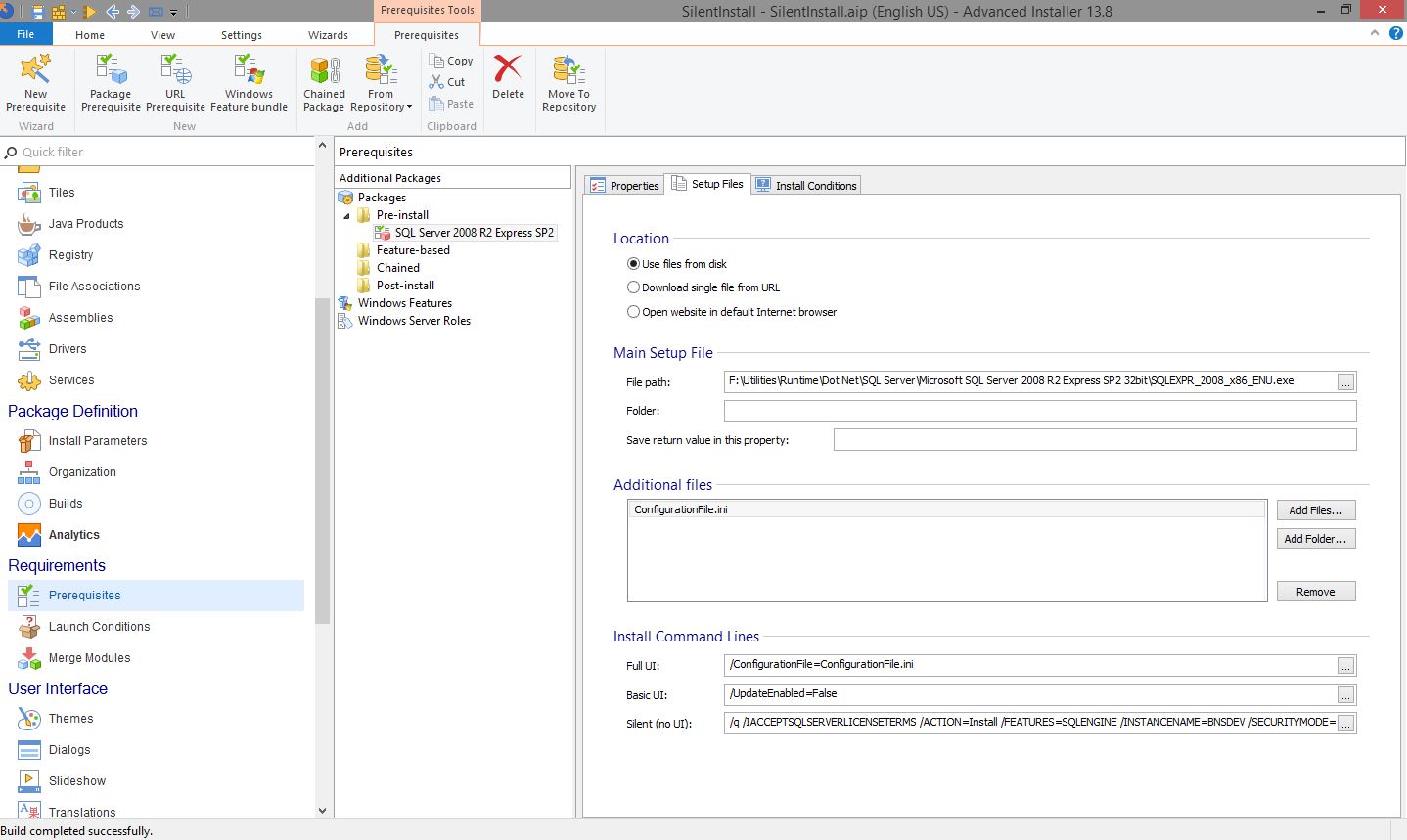

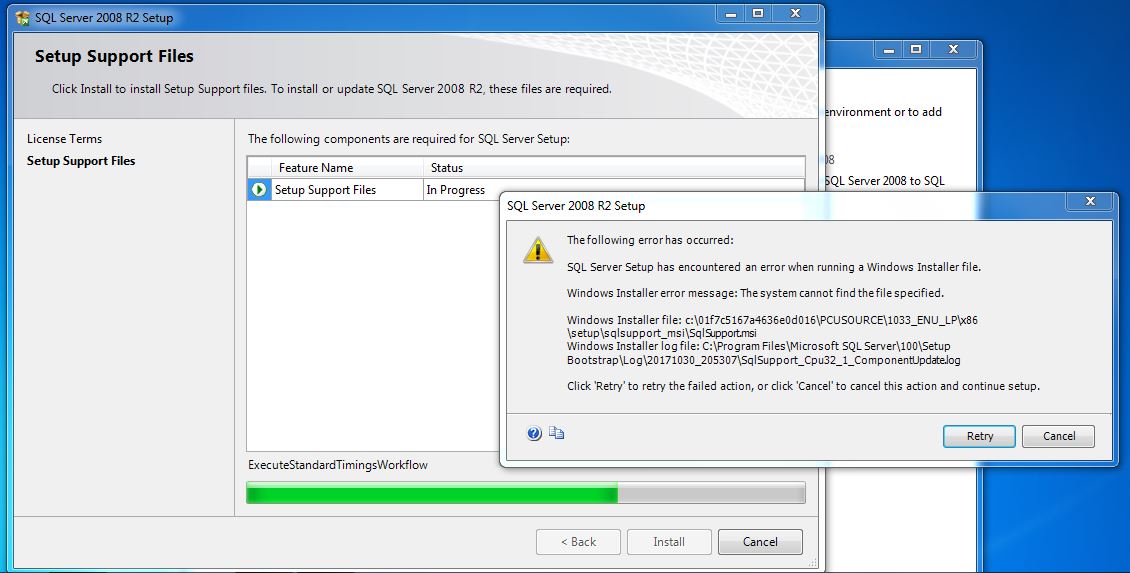
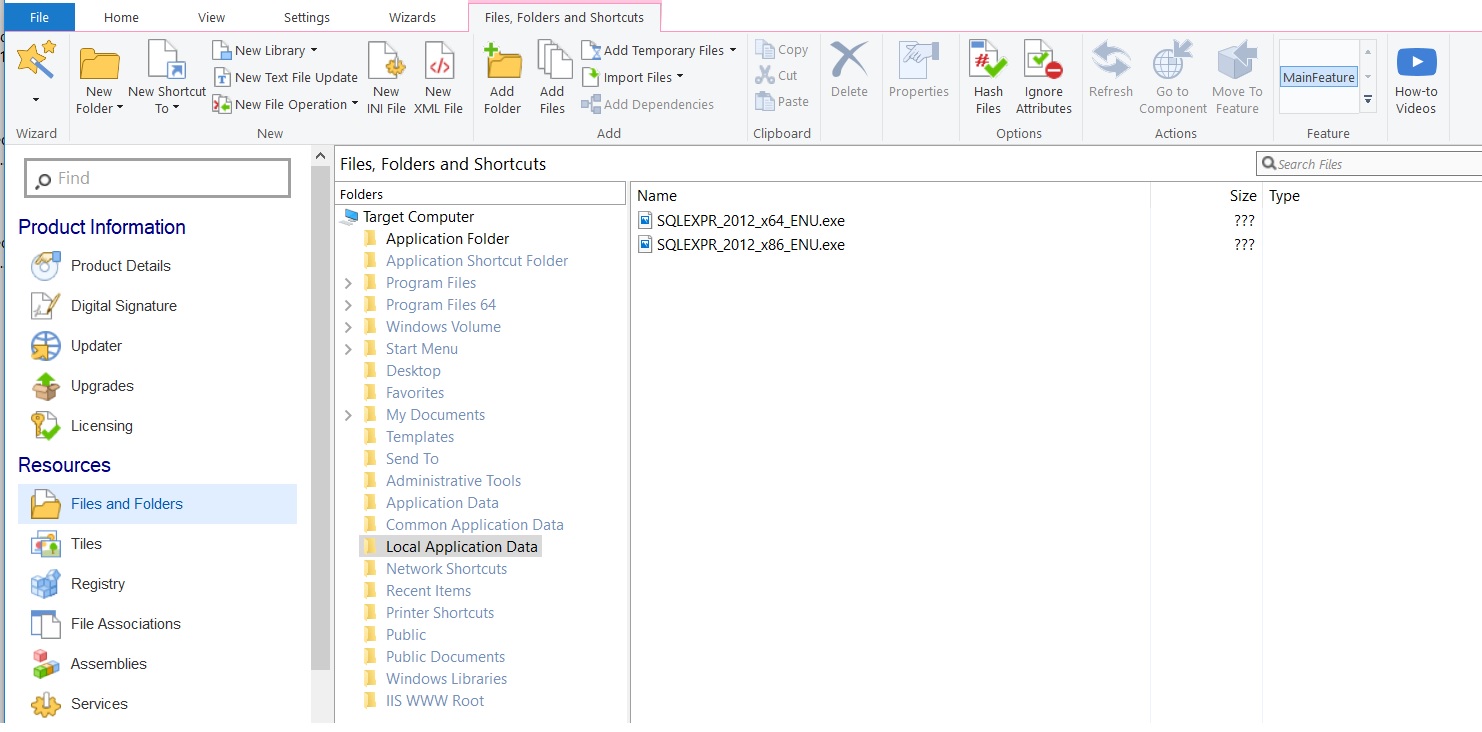
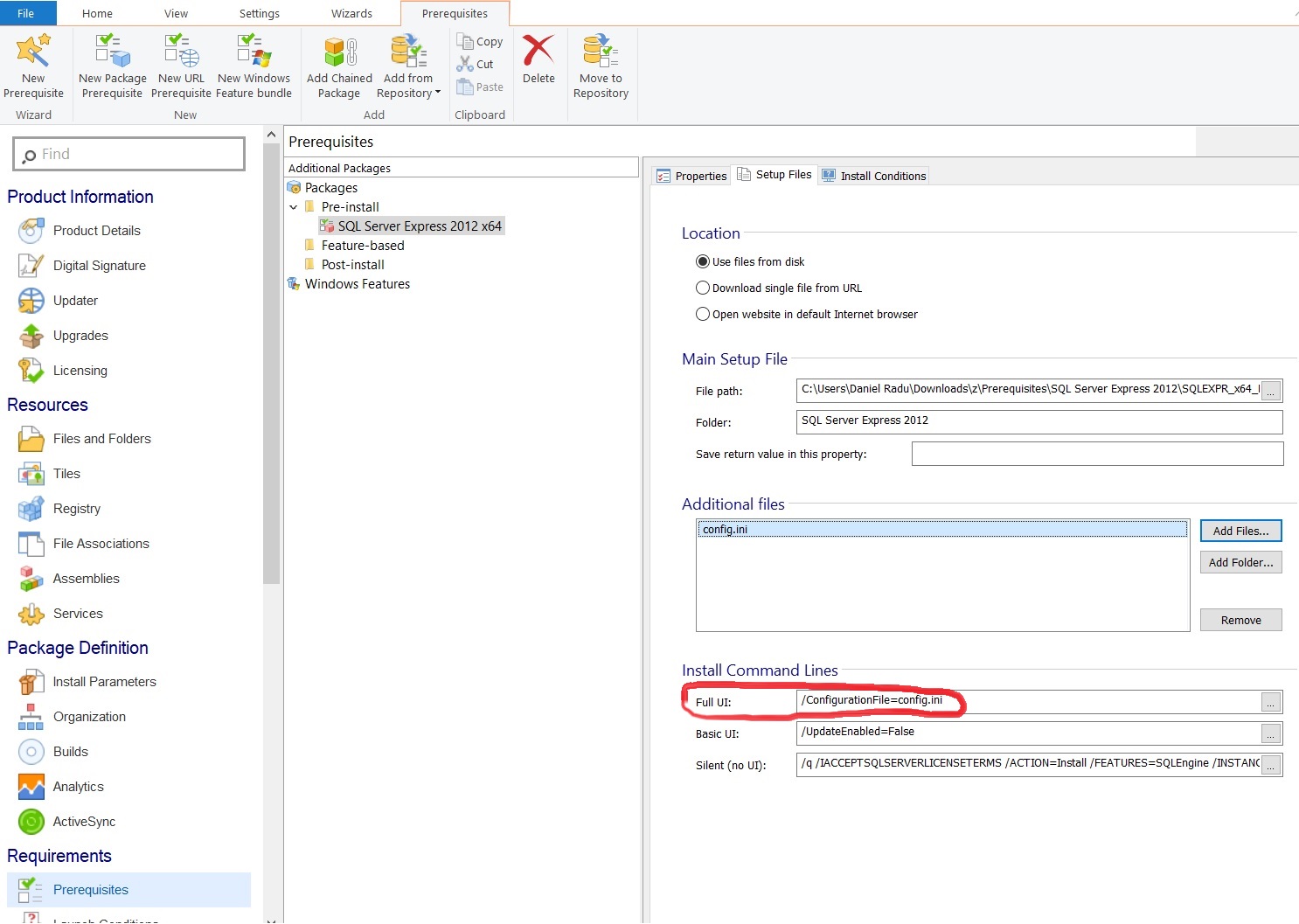
MS SQL Server 2016 Dev. The server was installed and running butsauser was not created. I ended up withFreshStartoption ofWin 10. It uninstalls everything (but keep user files) to emulate clean installation of Windows. Then the server was installed as charm. 1) Try to install on another PC. 2) Try FreshStart or clean install. – Kalasky